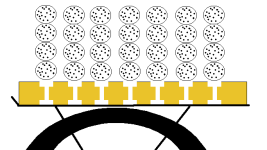BeggarsInSpain
1 mW
Hello,
I have been dreaming of a Fettering rotor for a bicycle. This device would impart the bicycle with wind power. I am not sure if I will have to power the rotor with electricity. I actually kind of think that because of the small mass of the rotor and the frictionless ball bearings that it will spin by pedaling the bike, giving it a kind of "wind-assist." I made the drawing to show how I might make the rotor attach to a luggage rack with a piece of wood that is counter-sunk for ball bearings. I made the picture so that the device has many rotors. Each rotor will drag and the amount of lift each successive rotor provides will be reduced from the first. So, it might be better to have fewer rotors. I think, that making the rotors taller changes the lift drag ratio.
It would be interesting to get a bike tuned to use a front hub motor and a Fettering Rotor. A bike that is capable of regenerating electricity from the wind and/or rolling down hills, so that it would get very good mileage.
From,
Tyler
I have been dreaming of a Fettering rotor for a bicycle. This device would impart the bicycle with wind power. I am not sure if I will have to power the rotor with electricity. I actually kind of think that because of the small mass of the rotor and the frictionless ball bearings that it will spin by pedaling the bike, giving it a kind of "wind-assist." I made the drawing to show how I might make the rotor attach to a luggage rack with a piece of wood that is counter-sunk for ball bearings. I made the picture so that the device has many rotors. Each rotor will drag and the amount of lift each successive rotor provides will be reduced from the first. So, it might be better to have fewer rotors. I think, that making the rotors taller changes the lift drag ratio.
It would be interesting to get a bike tuned to use a front hub motor and a Fettering Rotor. A bike that is capable of regenerating electricity from the wind and/or rolling down hills, so that it would get very good mileage.
From,
Tyler


